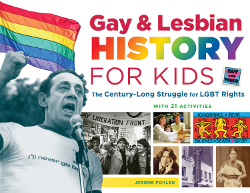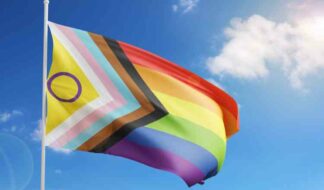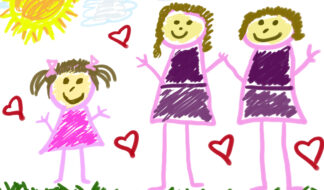
In celebration of LGBT History Month, author and former elementary school teacher Jerome Pohlen has written, "Gay & Lesbian History For Kids: The Century-Long Struggle for LGBT Rights with 21 Activities." The 180 page book is rife with photos, activities ranging from coloring to discussion, and historical information presented for children ages 9 and up.
The book begins with a handy timeline which highlights significant events by year (much like Between The Line's own smaller version in the Pride Source Yellow Pages). From referencing the Greek poet Sappho to the very current Obergefell v. Hodges ruling, the timeline manages to hit on key points in LGBT history beyond even the United States. The last 130 or so years of the timeline is then analyzed chapter by chapter, starting with an entry for July 22, 1893, though LGBT historical figures and events are still referenced in such times as ancient China and ancient Greece.
"Gay & Lesbian History For Kids" often has the difficult task of presenting history that at times can be considered speculative — for example, whether Katharine Lee Bates (who wrote the poem "America," which would later be set to music as "America the Beautiful") was a lesbian. Other figures discussed in the book that fall under the "Were they gay?" designation include William Shakespeare, Emily Dickinson, Henry David Thoreau and even President James Buchanan.
The book does navigate this issue well at the beginning, explaining to young readers that, "The further back in history you look, the more difficult it is to know who was and wasn't lesbian, gay, bisexual or transgender. The issue wasn't discussed often, and if it was discussed, it was usually in a negative way."
Throughout the book, positive glimpses of LGBT history do interweave in the often turbulent years of navigating LGBT rights. Adult readers may even be surprised to learn that laws against same-sex relationships were repealed during the French Revolution, or that Paris, referred to as "Gay Paree," is far truer to the LGBT turn of the phrase than they thought. Passages such as these widen the reader base of the book from children to adults.
There are multiple confirmed gay, lesbian and bisexual figures acknowledged in the book in addition to the murkier subjects. Dubbed "LGBT Heroes," people like Sir Ian McKellen, Sally Ride, Maurice Sendak and Ellen Degeneres are highlighted and most likely familiar to modern day children and adolescents. More historical LGBT heroes like Oscar Wilde, Bayard Rustin, Marlene Dietrich and Alan Turing are also featured.
The "T" is not left out in the history book, including particularly good coverage of Christine Jorgensen — one of the most famous transwomen in U.S. history. The section on Jorgensen is particularly well written, highlighting Jorgensen's ability to achieve positive popular reception at the time. The segment also describes how she navigated dealing with her parents while transitioning. Young children wrestling with their gender identity will hopefully find other segments, like the "two spirit" concept in many Native American cultures, to be similarly informative and uplifting.
Parents and guardians concerned about the potential adult nature of content in the book will be able to scan the easy-to-read book rather quickly. The violence and brutality of LGBT history is deftly handled. There are no violent photographs, either, as often found in history books for older adolescents. The death of Matthew Shepard, for example, is introduced with the phrase, "Aaron Kreifels was riding his bike along Snowy Mountain View Road on the outskirts of Laramie, Wyoming, when he spotted what he thought was a scarecrow tied to a fence. Looking closer, he realized it was the body of an unconscious young man, his face coated in blood." The imagery is gruesome, as was the attack on Shepard, but leaves out further details that could leave younger children uncomfortable or confused. Adults should also take note that "fag" is used throughout the book in historical quotes.
References to sex are inevitable in the book, particularly in light of the AIDS crisis; however, Pohlen manages to spend an entire chapter on the crisis with no more graphic a statement than, "HIV, which causes AIDS, is spread mainly through sexual contact."
For children or adolescents who may find the book, despite its rich photographs and clean graphic layout, difficult to read, the chapters are kept at reasonable lengths to keep even the youngest of readers on track. Activity sections throughout invite readers to go above and beyond simply reading or note-taking. One such activity invites readers to come up with their own symbol after learning about LGBT symbols such as the HRC "equal sign" and the Greek letter "lambda." Another activity guides students to draw a quilt panel for someone they would want to remember, deftly taking the difficult concept of death — particularly when learning about it during the AIDS crisis — and turning it into an art endeavor more palatable for younger "artists."










